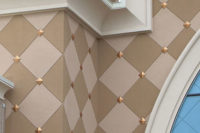There are some exciting new green building products that have been slowly making their way into the commercial market: an innovative insulating glazing unit, a super insulating aerogel blanket, and a rapid drying, self-curing concrete admixture. All of these products have the potential to dramatically change the building market, sustainability among their greatest benefits.
VACUUM INSULATING GLASS
Insulating glazing units have been getting more and more energy efficient over the past several years. High performance low-e coatings, gas infill (xenon, argon, and krypton), and proprietary edge spacers have all been employed with great success in rendering IGUs much more energy efficient. These technologies have reached their maximum potential, and although much better than 20 years ago, IGUs are still the most energy inefficient portion of the building enclosure.
About 10 years ago, the glazing industry came up with a way to get high thermal performance out of IGUs without the need to incorporate anything more than a vacuum between the glass lites. The lites are separated by small transparent “pillars” spaced evenly in a checkerboard pattern between the lites. Because the vacuum doesn’t need to be very large to function, the overall unit thickness is about 1/4 the thickness of a standard 1 inch thick IGU. Pilkington Spacia is currently the only vacuum insulating glass on the market, and has been in use for more than 10 years. The biggest advantage of such a product is as a replacement glazing for all the single pane glazing in older building stock. Vacuum insulating glazing units can be retrofitted into existing single pane framing, doubling, tripling and even quadrupling energy efficiency, depending on the glass and coatings selected for the VIG (The U-value range for VIG units is between 0.20 – 0.43).
Guardian Industries has developed a super vacuum insulating glass that it claims will achieve a u-value of 0.10. This product was supposed to have already been introduced to market, but due to economic considerations, it hasn’t happened yet. If and when the Guardian VIG goes to market, it will offer an attractive alternative to triple pane IGUs that are becoming more widely considered as energy codes continue to get tougher to meet.
AEROGEL BLANKET INSULATION
Aerogel is a superinsulating material that involves removing liquid from a gel substance and replacing with a gas. What makes an aerogel material work is that its porous structure’s pore size is less than air molecules, and so it acts like a vacuum, since air cannot enter the structure. Aerogel insulation has found its way into translucent glazing products as a superinsulating filler and is also being used as a component in a composite EIFS system made by Sto Corp called StoTherm In Aevero (and sold only in Germany, currently). This space-age material is now being offered in blanket form, for use as a building enclosure insulation.
The building industry is facing difficult challenges to design the building enclosure in a way that meets new, and ever changing, energy and building code requirements. The requirement for continuous insulation over exterior sheathing has resulted in thicker exterior wall construction, proprietary anchorage methods to accommodate this additional thickness, and combustibility issues when the insulation is made of foam. All of this has designers and contractors scrambling to find workable solutions, where few exist. Aerogel blanket insulation could be the solution.
Aspen Aerogels makes aerogel blanket insulation in maximum 2 feet by 4 feet by 10 millimeter thickness for use in buildings. R-value is about twice that of commonly used foam insulation, at R-10 per inch. Because aerogel blankets are not made with foam, current building code requirements for fire resistance testing to NFPA 285 do not apply to this material used as continuous insulation. The manufacturer claims that compressing the blanket (with fasteners, for example) has no negative impact on its insulating value.
For projects that require a bigger size aerogel blanket, Dow Corning makes a nearly identical aerogel blanket available in 200-foot-long by 5-foot-wide rolls at a cost of $5 per square foot. Dow has seen a steady uptick in use of this new material in buildings. It solves problems in locations where space is tight and thickness of conventional insulations will simply not work.
RAPID DRYING, SELF-CURING CONCRETE
One of the most bedeviling issues that designers, owners, and contractors have been grappling with for more than 20 years is moisture in concrete slabs scheduled for floor coverings. We have learned that slabs on grade need to be placed directly over a vapor retarder, and this has helped tremendously, but in doing so required additional reinforcement and a lower water/cement ratio—that means more chemicals. For slabs on grade, as well as suspended slabs, we have discovered that the best course of action often required is to apply expensive products to the surface to keep moisture in the slab from making contact with flooring adhesives. Even when following these best practices, floors over concrete continue to fail, and thousands of square feet of failed floor coverings are sent to the landfill every year. It doesn’t matter how sustainable the flooring might be, sent to a landfill prematurely doesn’t help the environment one bit.
A new kind of concrete admixture now available, promises to eliminate these problems. Called rapid drying and/or self-curing, these admixtures allow concrete to dry (and cure) from the inside, and make additional reinforcement, chemicals, and surface applied moisture barriers unnecessary. These special admixtures are self-desiccating, and consume the majority of the mix water during hydration, leaving a concrete slab that is dry and ready for floor coverings in less than 30 days. A company called Aridus in the US sells a rapid drying admixture to ready mix plants for a premium of about $4.00 per square foot over a standard mix design. The advantage to the contractor is being able to get the flooring installed within today’s ever- tightening schedules, with confidence that no failure will occur. Aridus promises a full refund if the slab is not ready to receive flooring with 45 days of placement.
CONCLUSION
Expect to see more of these three innovative, sustainable products incorporated into buildings as designers, owners, and contractors realize the problem-solving benefits they present. In addition, they each offer an added bonus of contributing to more sustainable, healthy, and energy efficient buildings. W&C







